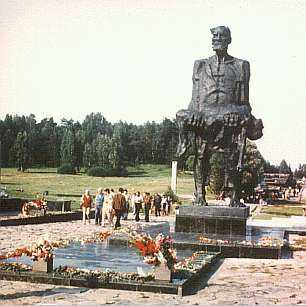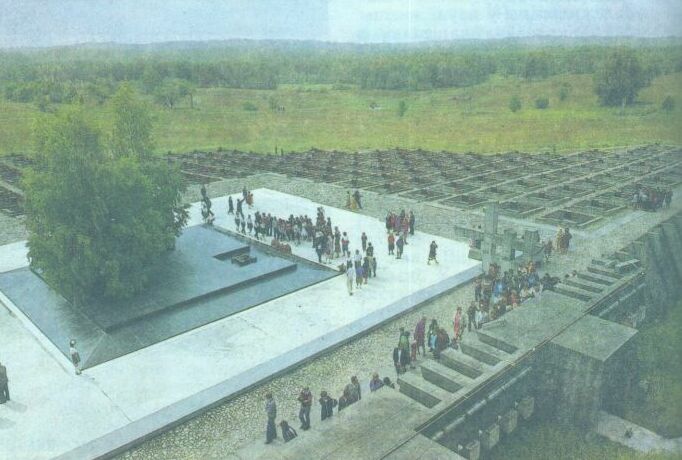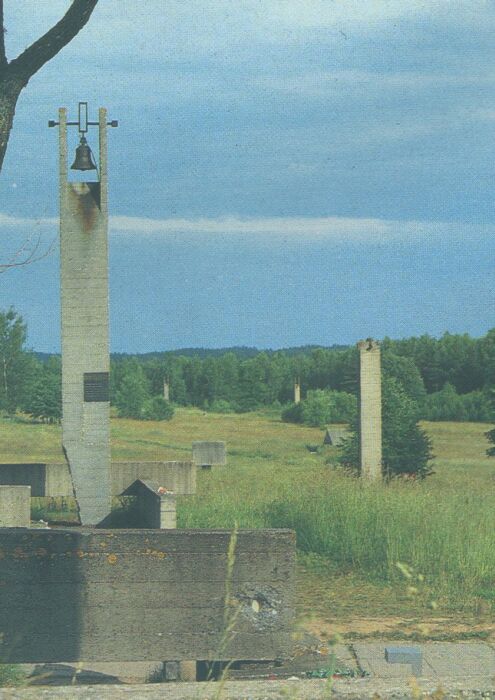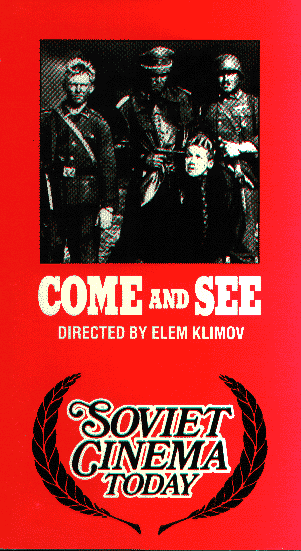 Khatyn WWII Memorial in Belarus
Khatyn WWII Memorial in Belarus Khatyn WWII Memorial in Belarus
Khatyn WWII Memorial in Belarus
"Good Folk, remember: we have loved life, and our homeland, and you. We have burned alive in flames. We plead to you: let our cries and grief turn into courage and strength, so that you can establish Peace and Rest on this Earth. So that nowhere and never life had disappeared again in a tornado of fire!"
March 22 1943 - 60 years ago - 26 houses with their inhabitants (149 people, including 75 children) were burned by the German punishment battalion in Belarusian village of Khatyn. The tragic fate of the burned villages is commemorated in a vast, spreading over 50 hectars, Khatyn' WWII Memorial, which was opened near Minsk in 1969. Khatyn' was not the only village with such a horrible fate. Population of 618 Belarusian villages was burned ALIVE by nazi during WWII in SS punishment operations against guerilla troops. 185 of burned Belarusian villages were never re-established after war - they have disappeared from the face of the Earth.

A handful of soil was brought from each of 618 burned alive villages and a symbolic Graveyard of Villages was founded in Khatyn'.
The memorial has 26 of symbolic chimneys with bells - creating an image of a burned village. Only brick chimneys were left standing when Nazis were burning log houses of Belarusian villages. Every hour the bells of Khatyn' are ringing to remind us about the horrible crimes that a human nature is capable off. Today the younger and happier generation prefers not to think about our history and look to the future, not to the past. But the safe future could only be built with a good memory of our past.
 The sculpture at the top is that of the only
survivor of Khatyn - Josef Kaminski. He was away from the village and when he returned all
his village was burned. Entire population of the village - 149 people, including 75
children- was gathered in a single wooden barn. First people didn't understood the
design of Germans. But when they smelled kerosene and saw the flames total panic broke out
inside the barn. People were throwing children into the tall windows of the barn in a hope
that they will have at least some chance at escape. Germans have surrounded the barn in a
ring and were spraying out of machine guns everyone jumping out of the windows of the
burning barn. Kaminski's son was shot this way too. Kaminski is shown in the sculpture in
an ultimate grief of a father holding the lifeless body of his son amidst the bare
chimneys of his burned village, his burned family, neighbors and entire life. Kaminski
stayed in Khatyn for the rest of his life. When I visited Khatyn around 1974 the guide has
respectfully shown him to us in the distance. He was cutting grass at the memorial alone
away from tourists.
The sculpture at the top is that of the only
survivor of Khatyn - Josef Kaminski. He was away from the village and when he returned all
his village was burned. Entire population of the village - 149 people, including 75
children- was gathered in a single wooden barn. First people didn't understood the
design of Germans. But when they smelled kerosene and saw the flames total panic broke out
inside the barn. People were throwing children into the tall windows of the barn in a hope
that they will have at least some chance at escape. Germans have surrounded the barn in a
ring and were spraying out of machine guns everyone jumping out of the windows of the
burning barn. Kaminski's son was shot this way too. Kaminski is shown in the sculpture in
an ultimate grief of a father holding the lifeless body of his son amidst the bare
chimneys of his burned village, his burned family, neighbors and entire life. Kaminski
stayed in Khatyn for the rest of his life. When I visited Khatyn around 1974 the guide has
respectfully shown him to us in the distance. He was cutting grass at the memorial alone
away from tourists.
Overall every forth Belarusian has perished during WWII - 2.2 million people, including 380,000 deported to Germany as laborers. 209 cities and townships and 9,200 villages had been destroyed in Belarus during WWII. The pre-WWII population of Belarus was only re-established in 1971. Every tourist in Belarus is striken by a number of WWII memorials. Peace is the highest and the most prescious quality of life that Belarusians cherrish. Not a single ethnical conflict has broken out in Belarus during the volatile post-USSR years. It is because Belarusians KNOW that any solution is better than the horror of war.
In my personal experience, I still remember my grandma's stories - how she was hugging my 5-yer old mother and 4-year old aunt in a cellar during German bombings of our city. She has decided for herself that if it is for her to die in the bombing then it is better to die together with her daughters. She was horrified by a thought that her 5 and 4 year old daughters would be left orphans amidst the cruelty of War. My mom still recollects how she and other children were terrified of SS-women - "esesauki"- and German shepard dogs. My grandfather was an artillery battery commander. He had fought as Stalingrad defender and died in this greatest battle of all. My father's family has spent most of the German occupation (1941-1944) in Resistance guerilla camp in Palesse forests. My father can still remember life there in a dug-out where his brother - my uncle - was born. Now you can appreciate why I and my family and majority of Belarusians are passionately ANTI-WAR.
 "Come
and See" - Bel.: "Idzi i hliadzi"
"Come
and See" - Bel.: "Idzi i hliadzi"
Produced by Belarusfilm and Mosfilm
Directed by Eliem Klimau
Starring Aliaksiej Krauc^anka, Vol'ha Mironava
"Set in 1943 German-occupied Belarus, the film follows an
adolescent boy through the nightmare that is war."
- IFEX International Video
"Come and See", based on a historical genocide, renders
excrutiatingly fresh the grief and madness of war."
- The Village Voice
Great beauty...Hypnotically sensual...It is a remarkable
cinematic achievement."
- Los Angeles Herald Examiner
The movie is graphically arresting. It is showing one by one the images that are imprinted in every Belarusian's mind. As I was watching it the stories of my grandma about the horrors of German occupation were constantly reemerging from the farthest corners of my memory. It is an extremely powerful movie. Anyone who wants to understand why Belarus is all covered with WWII memorials should see this movie. It shows the tragic last days of the Belarusian village whose inhabitants were burned alive in SS punishment operation. COME AND SEE if you don't want it ever happen again.
This movie is released in US by IFEX International Video. You can purchase it from N.Y.C. Kino video. "Come and See" is also carried by REEL
References used in page:
"Arhitektura Belarusi. Encyklapedychny davednik" ed.: A.A. Voinau and others, Minsk, Publishing house "Belaruskaia Encyklapedyia" named after Piatrus' Brouka, 1993. ISBN 5-85700-078-5.
"Historical Dictionary of Belarus" by Jan Zaprudnik, The Scarecrow Press, Inc.Lanham, Md. & London, 1998, ISBN 0-8108-3449-9
Link to official website of Khatyn memorial in Belarus
 This file is a part of the Virtual Guide to Belarus - a collaborative project of Belarusian scientists and professionals abroad.
VG brings you the most extensive compilation of the information about Belarus on the Web.
This file is a part of the Virtual Guide to Belarus - a collaborative project of Belarusian scientists and professionals abroad.
VG brings you the most extensive compilation of the information about Belarus on the Web.
Please send your comments to the authors of VG to
Belarus
History | Statehood | Culture | Law
and Politics | Cities | Nature and Geography |
©1994-04 VG to Belarus
Disclaimer